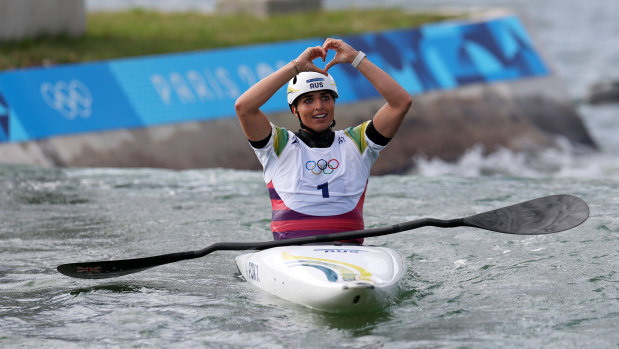- Science of Sport
- Sport
- Paris 2024
Jess Fox and the almost impossible balance between speed and precision
After her stunning success in the women’s kayak single class on Sunday, Australia’s Jess Fox will be aiming for her second gold medal in Paris when the canoe slalom event gets under way at the Vaires-sur-Marne nautical stadium on Tuesday.
But even for the undisputed greatest paddler in history – with 10 world titles and two Olympic golds – there are no guarantees in an event as chaotic as the canoe slalom. Fox’s win on Sunday will have shown you why.
Canoe slalom is a sport that defies simplicity, combining supreme athleticism with an intricate understanding of fluid dynamics.
Competitors navigate a course of up to 25 gates suspended above a tumultuous stream, engineered to transform placid water into a maelstrom of white rapids and eddies.
So, the race itself presents a unique tactical challenge, yet the competitors must memorise the course layout and set their race plan after only a visual inspection.
Adding to the complexity, the course is changed before the finals, ensuring an entirely new challenge for competitors.
But the physics of the sport are as complex as the course itself. The canoes, essentially keelless hollow tubes, require extraordinary balance and control. It’s as easy to capsize the canoe as it is to stay upright and paddling.
And the paddles used by the athletes add to the complexity. Their wing-like shape generates lift forces akin to those of an aircraft wing, propelling the boat forward through a sophisticated sweeping motion rather than simple backward strokes. So, both propelling the boat and righting it as it tips requires an angled sweep of the blade that is far from simple.
Navigating the course also demands a nuanced understanding of hydrodynamics. Paddlers must read the water’s complex movements, anticipating how the engineered obstacles in the course will affect the flow to find the fastest path to the finish line.

Jessica Fox celebrates after her faultless run in the women’s slalom on Sunday.Credit: Getty Images
They must thread through downstream gates marked in green and battle upstream through red-marked gates, often manoeuvring sideways or backwards as the chaotic currents dictate.
While the order of gates is set in stone, the path they take is not. As each competitor decides on their path, some will choose wisely while others lose time.
And, to add to the technical difficulty, the physical demands are also immense. In a race lasting a gut-busting 100 seconds (Fox’s time on Sunday was 96.08), athletes must combine explosive strength with endurance, all while making split-second tactical decisions. As the arms begin to burn, mistakes become more likely.
Top competitors employ biomechanical strategies to maximise efficiency, such as positioning their boat near a gate and using their body’s momentum to pass through while the boat continues on a different trajectory given that only the competitor’s head and a small part of their boat has to pass through the gate.
Precision is paramount. Athletes aim to pass within millimetres of the gates, but even the slightest touch incurs a two-second penalty.
In a sport where victories are often decided by fractions of a second, these penalties can be catastrophic. Fox herself experienced this in a recent World Cup race, where the slightest touch of just two gates cost her the victory despite achieving the fastest overall time.
So, as the canoe final approaches, the question looms: can Australia’s golden girl once again harness the chaos of fluid dynamics and use her incredible physical talents to claim victory once again on the world’s biggest stage?
In this discipline where Newtonian physics meets athletic prowess, the outcome remains thrillingly uncertain.
For Olympics news, results and expert analysis sent daily throughout the Games, sign up for our Sport newsletter.